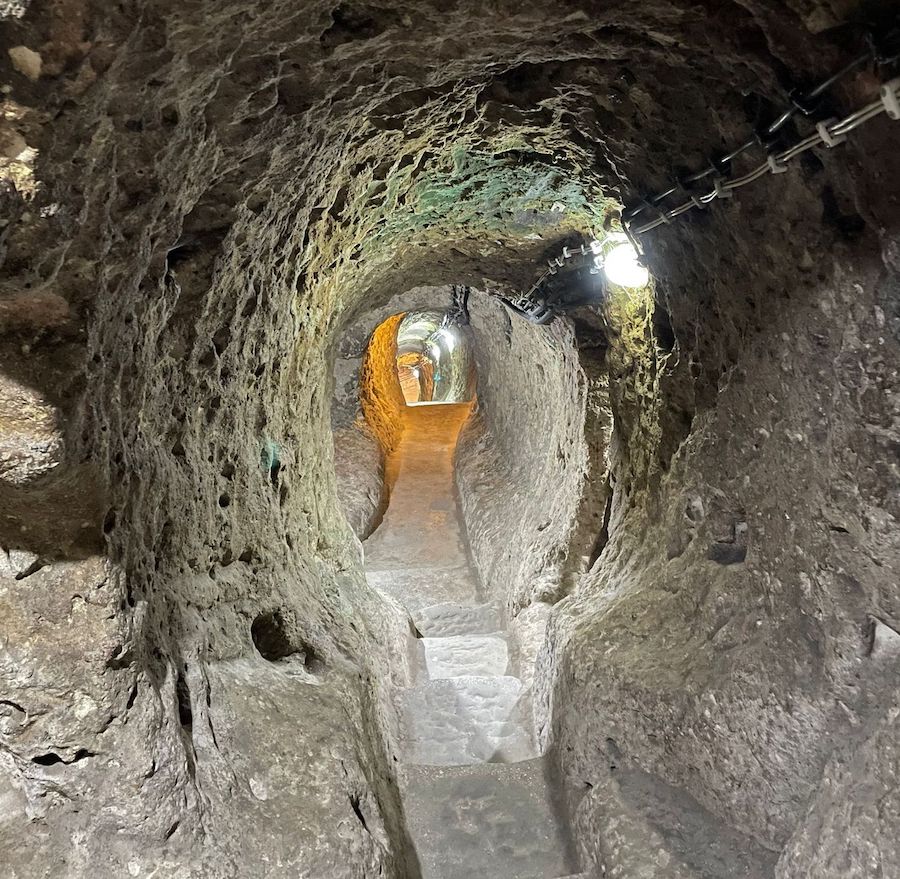Nestled in the heart of Turkey, the Cappadocia region is renowned for its stunning landscapes, fairy chimneys, and unique rock formations. However, beneath the surface lies a hidden world: an intricate network of underground cities that have captivated historians, archaeologists, and adventurous travelers alike.
A Glimpse into History
The underground cities of Cappadocia, particularly Derinkuyu and Kaymaklı, date back to ancient times, with evidence suggesting that they were initially carved out as early as the 8th century BCE. These subterranean labyrinths served as sanctuaries for local populations during times of conflict and invasion, particularly during the Byzantine and Roman periods. The region’s unique volcanic rock made it relatively easy to excavate and shape, allowing for the creation of extensive underground dwellings.
Architectural Marvels
Derinkuyu, the largest known underground city, is a marvel of engineering. It extends to a depth of about 60 meters (approximately 200 feet) and could accommodate thousands of people. The city is equipped with various facilities, including living quarters, kitchens, wine and oil presses, storage rooms, and even ventilation shafts that allowed fresh air to circulate throughout the depths.
One of the most fascinating features of these cities is their multi-level design. Derinkuyu alone has at least eight levels, each serving distinct purposes. The lower levels were typically reserved for livestock, while the upper levels contained the living areas and communal spaces. The architecture reflects an impressive understanding of urban planning, ensuring that even in the depths of the earth, residents could thrive.
A Refuge from Danger
The underground cities were not merely residential spaces; they were designed for survival. Narrow passages and heavy stone doors could be sealed from the inside, providing safety from intruders. The cities also had strategic escape routes that led to the surface, allowing inhabitants to flee if necessary.
During times of war or invasion, these underground havens became lifelines for the local population. It’s estimated that the underground cities could shelter tens of thousands of people, providing a refuge that was both secure and resilient.
Cultural Significance
Beyond their architectural and historical value, these underground cities offer insights into the cultural practices of the people who once inhabited them. The presence of churches, communal kitchens, and prayer rooms indicates a rich spiritual and communal life. Today, these cities are a testament to the resilience and ingenuity of the people of Cappadocia, who adapted to the challenges of their environment and circumstances.
Visiting the Underground Cities
Today, the underground cities of Cappadocia are a popular attraction for travelers seeking to explore this unique aspect of Turkey’s heritage. Guided tours are available, allowing visitors to delve into the history and mysteries of these subterranean wonders. While exploring, it’s crucial to note the dim lighting and narrow pathways, which can make for a thrilling yet slightly claustrophobic experience.
Notable Underground Cities
Derinkuyu
- Size and Structure: Derinkuyu is the largest underground city in Cappadocia, with the capacity to shelter around 20,000 people. It spans over 18 levels, though only a few are open to the public.
- Key Features: It includes a church, a school, kitchens, and extensive storage areas. The ventilation shafts—approximately 100 of them—were crucial for air circulation, ensuring the inhabitants’ survival during long periods underground.
Kaymaklı
- Access and Layout: Kaymaklı is another prominent underground city, known for its complex layout with around eight levels accessible to visitors. It features large communal spaces and narrow tunnels that connect different sections.
- Unique Aspects: The city was designed with a series of large, round stone doors that could be rolled into place to block entrances. This made it easy to seal off entire sections in case of an attack.
Other Underground Cities
Besides Derinkuyu and Kaymaklı, there are several other lesser-known underground cities, such as Özkonak and Mazı. Each has its unique features and stories, showcasing the vast network of underground habitation in the region.
Living Conditions
Life in the underground cities was likely challenging. The lack of natural light and fresh air made it essential to create efficient systems for living. Rooms were often carved into the rock, providing basic but functional spaces for sleeping, cooking, and community gatherings. Food storage was crucial, and many of the cities contained large storage areas for grains, dried fruits, and vegetables. Water was accessed from underground wells or through cisterns, ensuring that the population had enough resources even during prolonged stays underground.
To further enhance security, the cities featured trap doors and hidden chambers. Some areas were designed to confuse intruders, with deceptive passageways and dead ends. The design of these cities reflects a sophisticated understanding of defense mechanisms.
Visiting Tips
- Guided Tours: To make the most of your visit, consider joining a guided tour that provides historical context and anecdotes about the underground cities.
- What to Expect: Be prepared for narrow passages and steep stairways. Some areas can be quite cramped, so wearing comfortable clothing and sturdy shoes is advisable.
- Photography: While photography is often permitted, be mindful of the low lighting and respect the historical significance of the sites.
Today, the underground cities are recognized as UNESCO World Heritage sites, highlighting their importance not just to Turkey but to global history. They serve as a reminder of human ingenuity and adaptability.
The underground cities of Cappadocia are a remarkable testament to the resilience and creativity of ancient civilizations. They offer a unique glimpse into a world where survival depended on both community and ingenuity. Whether you’re a history buff, an adventure seeker, or simply curious about human stories, exploring these subterranean wonders is an unforgettable experience. So, when you plan your trip to Cappadocia, don’t miss the chance to venture underground—there’s a whole other world waiting for you!


Share:
Cappadocia Hot Air Balloon History
Discovering the Castles of Cappadocia